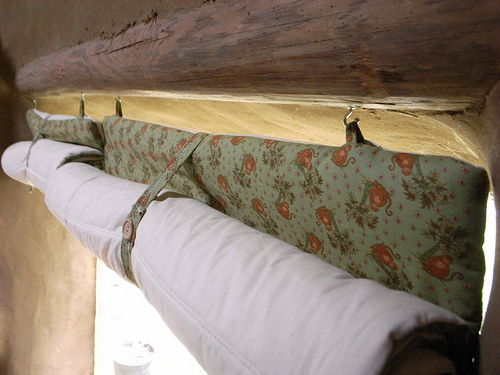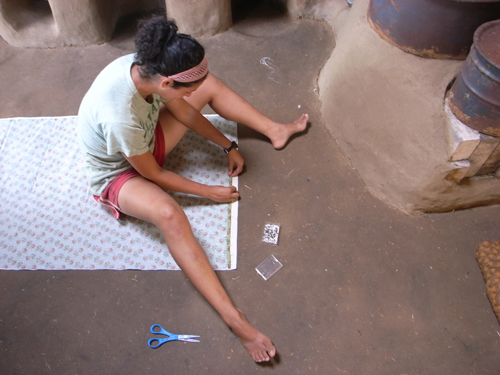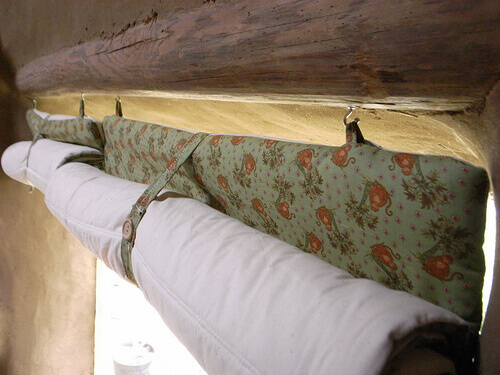
Windows are very frequently a source of lost heat in your home. Older homes may suffer from only having single-paned windows, which lose a large amount of heat, and even newer double-paned insulated windows lack enough insulation against cold winter temperatures and wind. However, you can save home heating costs and easily bulk up the insulation around your windows by making your own inexpensive thermal curtains.
Thermal curtains are energy-efficient window shades that insulate against the cold around your windows. They are a thick and heavy buffer and can significantly decrease the money you spend on energy to heat your house. If you are handy with a sewing machine or know someone who is, there’s not much more you need than some old blankets or comforters, fabric, and a fair amount of time.
How To Make Thermal Curtains
Old comforters make for a great filling in thermal curtains, especially since they can be had for very cheap ($5-10) at your local thrift store. Get a few of them. Doubling the comforter will increase the insulative value and add weight to keep your curtains pressed tightly against the wall.
Measure your window and find something strong and solid (imagine a rigid dowel or heavy stick) to span the bottom of the window to give your curtain some structure (and to make it easy to roll up and down).
You can use just the comforter itself for the curtain if you are looking for a very quick and dirty solution, or you can pick out some fabric to be sewn over the material for a more pleasing aesthetic.

Cut your fabric a couple inches larger than the actual window measurements. To make cutting your fabric easier, place the two pieces of fabric with the fronts facing each other and your comforter layer(s) all in one pile and cut them simultaneously. Be sure to pin them together to keep them from shifting while you cut and then sew the fabric together.
Next, sew the materials together on three sides. On the final fourth side, sew about 1/3 of the length from each corner, leaving an unsewn portion in the center. Use the hole that you left unsewn to flip the curtain right side out. Then place your dowel or heavy stick between the layer of fabric and comforter at the bottom of the curtain. Finish the curtain by sewing your hole shut.
You can use a variety of methods to actually hang your new thermal curtains. You can sew velcro to the top back side, or sew small fabric loops on the top and hang the curtain from hooks mounted on the window frame. Be creative.
Thermal curtains are a cheap and easy way to save energy costs in your home. They can largely be made with reused and recycled materials.
Roll them down on cold winter nights, or even during a hot summer day to block the sun’s rays and save energy costs!









































I haven’t done a stitch in a while, but I’m sure my wife won’t mind sewing one of these for our house. We had a terrible winter, and couldn’t help but keep the heater on for most days, and nights especially. I was telling her that we need to do something non-electrical to help rid of the cold next winter. This will be on the list. Thanks for sharing!
These are a quick method of creating Warm Window curtains, which are Roman shades (pull up accordion style) using a multi-layered fabric manufactured by the Warm Company. I sewed these curtains for our entire house, including skylights (over 29 openings!). We noticed immediately that our fuel usage dropped to about a third of what it is (even with dual-glazed windows).
Window coverings seem to be one of the most ignored ways to insulate the home — and windows are a major source of heat loss. The Warm Window fabric has polyester batting, pinhole mylar and polyester, silvered mylar (a moisture barrier). The main thing is that they take time to sew. But oh they’re sure owrth it.
You can get the silvered mylar, or emergency blanket from Edmund Scientific. I made curtains as per the directions above, using drapery fabric, quilt batting, and the emergency blanket in layers.
Nice post. I was kinda skeptic about the idea of energy saving curtains. But its now a really simple thing to do
I support you just for the word “energy saving”
I believe green living is not mean doing something to save little energy ,but an idea of living . An idea of that live in a frugal way , make use of thing from nature as far as possible .
The idea must be belief ,but not slogan !
Great idea. Even our double gazed plastic cased windows allow alot of cold air in.
Why the big gaps around the edges?
It seems that lots of heat would be lost. I would make sure they fit snugly.
What a great tutorial!
Do you guys think these would help keep the summer heat out of our house? We live in Austin, TX where you worry more about the summer heat and keeping your house cool than the winter. Our house is unfortunately positioned so it’s catching SO MUCH afternoon sun through the windows and really heating up our living room.
Any advice would help!
We have a ton of skylights and large windows in our house. We like the light, but in the summer it heats up fast. In our kitchen (three large skylights) we put in powered honeycomb blinds. They’re pricy, but in the winter we open and close them quite a bit (closed at lunchtime to reduce glare, open at other times to admit heat, closed at night to reduce heat loss. In the summer, we keep them closed. They admit light, but greatly reduce the heat gain. In another room, we had two even larger skylights (48×66) and (48×90). I wanted a similar, but cheaper solution. I bought three door panels of muslin-like fabric for the smaller skylight, sewed a pocket in the middle, and used three tension rods. Light still gets through, but the heat gain is drastically reduced. In the larger window, I bought three pairs of curtains that matched the door panels, and stitched them together with the rod pockets out and the hems together. I made a pocket in the middle and put it up using three tension rods. Because of the added length, this one was a little droopy, so I used a staple gun to attach the sides to the window frame. Again, it worked well!
We lost a tree to a hurricane last year and now my living room, which faces south, heats up in the summer. Problem: I need a window covering for our large picture window (102″ wide) that can be tossed in the washer and not hung to drip dry or requiring dry cleaning. Suggestions? I am a sewer and will consider this option. Thanks, everyone!
have you tried making panels with velcro on the edges so that when you put up the curtain the velcro holds the panels in place but when you need to wash the panels you can do so in stages (thereby fitting it all in the washing machine.)
maybe making each panel about the size of a full sized bed or queen sized, depending on how big a comforter you could fit into your washing machine.
you would need to make sure to get washable and heat safe velcro and you might not be able to make the covers too thick but ????
When my son was a baby, I needed something to darken the room for naptime. I took one of his blankets (one of those tied fleece blankets) and wove a curtain rod through the knots. Not only did it darken the room substantially, but it helped keep the heat out and the cold! It was a two layer fleece blanket, that the fringed edges are knotted together. Worked beautifully. Better than the $30 blackout curtains from Walmart!
Awesome – thanks for sharing, Tori!
I’m late to the party, but that’s okay. 🙂
It’s the first winter in our new house and we’re slowly discovering its… Quirks. For example, that the windows weren’t insulated properly by the last owner who replaced them, that all the largest windows face the prevailing wind (which is currently blowing hard and at about -30 degrees C), and that the doors don’t fit quite right. Sigh.
Some of these are easily and inexpensively fixed — weatherstripping, caulk, and window film — but the cost of thermal curtains was bringing me down. Time to hit the sewing machine…
Thanks again for the great ideas.
I use duct tape, bubble wrap on windows for curtains, they can be custom fit by sewing to calico on both sides, then hung to rods
Made mine about 10 years ago using an old mattress pad as the inside and sewed rod pockets on both ends of the back or window side to put spring tension rods thru. Then I could raise or lower much easier.
Pls forgive my ignorance but I see so much gaps in that window. I don’t see how these curtains are present the air from getting in/out. Am I missing something? Thx.
Hi, Teresa – If I say something too obvious here, let me know: that curtain would be unrolled when the weather gets cold. If that’s not the issue, and it’s just the gaps between the curtain and the wall surrounding the window, I don’t think they prevent the air from getting in/out, but vastly slow it down and still create a space that works somewhat like a double-paned window.
Do these get moldy? My windows attract a lot of condensation and frost, and I’m constantly fighting mold on my windowpanes because the frost keeps the wood damp. It might be a good idea to use a fabric on the inside (window-facing) layer that can be wiped clean.
Good question, Sabriel! I’d also imagine that if you sewed them tight enough, you could throw them in the washing machine, too.
There is also the plastic film for inside you heat with a hair dryer and you can see through, but can not open or reuse.
These work great in the summer too, to keep heat out
they work on doors too.
they need air space to reduce condensation insulate and stop air movement and can not touch glass
they need to be larger than the window, by more than a little bit
they need to be closed off at the top or they are like chimneys
i made loops and placed small hooks around the frame so they fit sort of like a tarp, i roll them up when i need to, and remove them at other times or just cover part of the window. Very handy to darken a room too.
I made them with cheap fleece blankets as the filler and old cotton/poly bedspreads that i dyed all the same. if your windows are breezy, and it gets very cold, things will get damp no matter what, so make them easy to wash. I made panels no bigger than fit in my washer
it is -40 often where i live, and i have old leaky windows and heat with a wood stove.
i am very cozy, and really only use the window quilts when it is windy
i love wood heat that lets me open the windows even in the depths of winter. I take out the screens in the winter just so i can lean out on sunny days and get the sun on my face.
could put bubblewrap inside it as added insulation barrier with the aluminum casing on it would be stiff but work better for insulating.
Interesting ideas, Doug… thanks for chiming in!
laundering would be impossible with it inside. Perhaps putting bubblewrap on the window itself to buffer before the curtain?
This shows creativeness and resourcefulness. This own made energy saving blinds won’t just save money from buying a window blinds, it also gives a warm feeling and can certainly help in saving money from spending on energy to heat your house
Cut a section out of a survival blanket and put it in the middle. will make a HUGE difference as those things have a 90% heat reflecting ability.
Great suggestion, Timothy… thanks for chiming in!
pfft….you beat me to it.
In the middle? As in between the fAbric? Are they washable ?
How would you ever wash something so heavy? My washer can handle a single comforter every once in awhile, but it often unbalances it
.
Put towels in the empty space to balance it out 🙂
but these directions have you putting the Wooden Stick IN the curtain at the bottom. that would have to be taken out before any cleaning beyond dunking in a bath tub
make a casing in the bottom for the stick to slide in and out for washing
Seal the edges, especially the top and bottom, or else you are making a steady flow of refrigerant slide down the glass. Your warmest ceiling air will pass over the glass and deliver chilly drafts at the floor – even more than a window with no curtain at all!
An air tight seal, or do you think velcro or something like it would work?
velcro is great, but not even needed.
If, in the top photo, the hanging hooks were on TOP of the wood window frame, the cloth would hang and probably seal 99% of air flow. You would lose the good looks, so perhaps use a second cloth as a baffle. This is cheap: attach the second cloth, one foot wide, all along the base of the wood, and pull it over the top of your hanging drape. That seals the warm ceiling air from entering the cold glass side. The edge seals are another challenge – what would YOU suggest?
Maybe attach some buttons to either side of the window? It might be a bit weird when you want to open and close the curtain and have to unbutton it, but it would look cute. 🙂
Use magnets. You can put an adhesive backed strip along the window frame and along the sides of the curtain – the magnets stick together and the window is sealed off.
Don’t suppose i can have a curtain comissioned, im useless at sewing and everything needed here XD
http://www.artwithanrvalue.com
Remember that heat rises so if you’ve got a gap at the top where it hangs you’re losing heat.
Thermal Curtains and Blackout Drapes can spice up any room in your house
This stuff is cheaper, lighter, requires no sewing and allows light into the room.
https://m.acehardware.com/product/index.jsp?productId=1286194&KPID=984182&cid=CAPLA:G:Shopping_-_Catch_All_-_New&pla=pla_984182&k_clickid=9acdcdca-5157-423d-abaf-0bd8cf440edc&gclid=CjwKCAiA-KzSBRAnEiwAkmQ15649iWeqLHxHz25ZXWcRlgt1tYGu2OSD1dGa9mjvMJExiG4VpLhuTxoCKtkQAvD_BwE